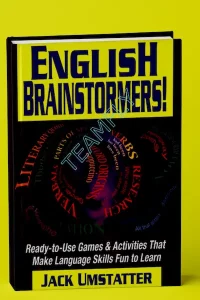English Brainstormers Ready For English and language arts teachers in grades 6-12, here’s a unique collection of over 180 fun-filled, ready-to-use activities that help build the skills your students need for test-taking and overall academic success.
English Brainstormers Ready to Use Games and Activities
Lately, we teachers have been bombarded with educational terminology such as “The State Standards,” “Learning Assessments,” “Academic Intervention Services,” and “Competency Evaluation.”
Yes, the new standards are probably necessary for some students for a number of reasons. Yes, students who are not performing up to a specific standard should be given remediation.
Few would argue against either. Yet, through all of these assessments and evaluations, many teachers confess that the joy of teaching, the “fun in the classroom,” has been slowly disappearing.
Instead, pressure and stress for both you and your students have appeared. How often have you heard, or even said it yourself, “There is little time for anything other than preparing my students for all these assessments!”? In a nutshell, we need to make learning fun again—both for ourselves as teachers and, more importantly, for our kids as learners.
Plain and simple: Students love fun activities. Because of the many and varied skills that we are asked to teach our students each day, the classroom is an ideal place to incorporate fun activities to introduce and review the various language arts skills including grammar, mechanics, word development, vocabulary, research, critical thinking, and creative writing, to name just a few.
Fun involvement—what a wonderful way to achieve classroom goals and improve language arts skills at the same time! Will our students’ test scores suffer because we include some games and other enjoyable and worthwhile activities in our curriculum? No! Studies support the fact that students retain more when they are actively involved or have “hands on” in the learning process. Through such activities, students will certainly absorb more information as they learn, review, and retain concepts in your classroom. Plus, they will be enjoying themselves at the same time! What a great combination!
The 181 entertaining activities in English Brainstormers! will make your students’ time in the classroom informative, enjoyable, and entertaining. Students will look forward to these creative, ready-to-use, classroom-tested activities.
These learning activities can function as introductions, reinforcements, or homework assignments. They can be used as individual, group, or whole-class activities. Many of these activities will serve as time-fillers or extracredit assignments.
Formatted as crosswords, word finds, riddles, magic squares, word generators, jumbles, and more, these learning activities will motivate your students to think more astutely and want to do their best in the process.
The resource is divided into seven sections, as follows:
- Section One, “This Is Not Your Grandma’s Grammar,” includes 29 activities designed to review and reinforce parts of speech, verbals, phrases, clauses, sentences, spelling, diction, syntax, mechanics, and plurals.
- Vocabulary, prefixes, roots, suffixes, word construction, synonyms, antonyms, word and phrase etymologies, and word recognition comprise the 29 activities in Section Two, “Playing with Words.” Students will become more word curious, “word wise,” and more confident in their everyday writing and speech.
- The 26 activities in the third section, “Getting Set for the Standards,” will help your students become more versatile and intelligent learners and test-takers. These activities include work with synonyms, quotes, topic sentences, essays, word expressions, spelling, vocabulary, the cloze method of reading, and mechanics. Students will also perform tasks similar to those found on typical standardized tests.
- In the fourth section, “Really Writing and Really Discussing,” students will work on the 24 activities that include poetry interpretation, literary and character analysis, creative thinking, idioms, expository writing, creative story writing, and discussion. Here they will compare their views on many interesting topics and issues. An examination of the techniques and styles of various writers is also found in this section.
- Section Five, “Critical Thinking Is Critical!” presents 25 activities designed to improve students’ critical-thinking skills. Exercises involving word origins, word play, spoonerisms, imagination, logic application, character analysis, examining evidence, associative thinking, creative thinking, and other interesting real-world applications are found within this section.
- The sixth section, “Researching and Remembering,” incorporates many of the concepts and tasks necessary to write reports and deliver speeches on various topics. Grouping pieces of biographical, literary, historical, or geographical information, researching elements of the English language, comparing and contrasting different literary genres, working with quotations, finding information about famous people, and assessing a literary situation are just some of the 23 games and activities that your students will enjoy here.
- “You Are Special!” is the concluding section. Many of these 25 activities focus on the students and the world around them. Whether it is a personal inventory exercise, a descriptive personal writing, an autobiographical sketch, a “most important moments” list, an evaluation of various literary characters, a personal decisionmaking activity, or a look at what the students think about themselves and others, these activities are designed to make your students think more maturely and insightfully as they assess the world around them.
It was William Butler Yeats who said, “Education is not filling a pail, but lighting a fire.” You will light that fire, and your students will be filled with enthusiasm as they do these activities. I know. My students do. Yours will, too. Enjoy!


